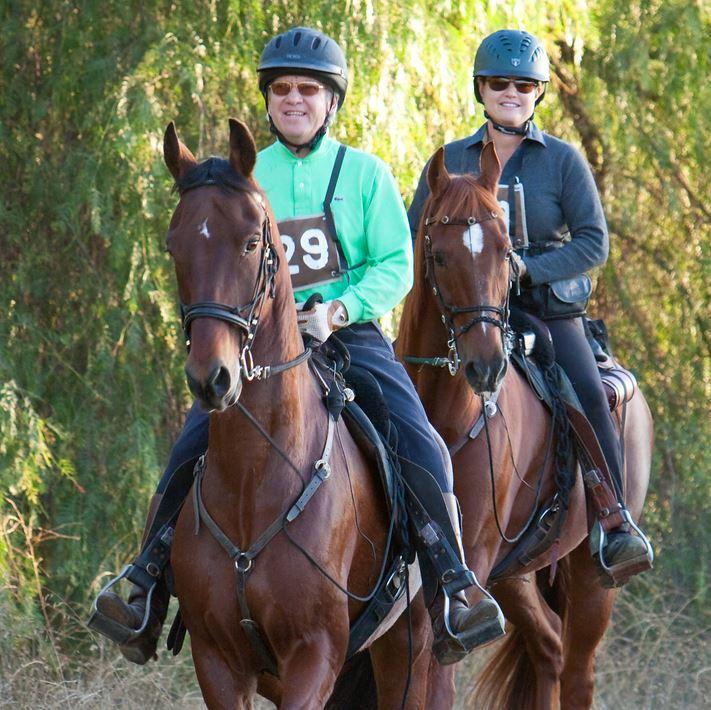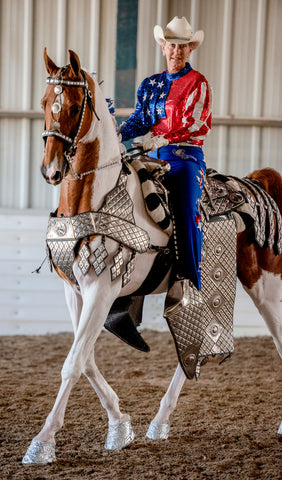

American Saddlebred
Photos © American Saddlebred Horse Association
Breed History

The American Saddlebred horse can trace its roots to the naturally-gaited Galloway and Hobbie horses which came to North America from the British Isles. These hardy little horses thrived and grew in their new environment, and through selective breeding, the Narragansett Pacer was developed along the eastern seaboard. The Narragansetts were crossed with Thoroughbreds imported to America in the early 1700s, and by the time of the Revolutionary War, a horse called simply "the American horse" was a recognized type.
These horses had the size and beauty of the Thoroughbred, but retained the ability to learn the easy-riding gaits. These animals were used for riding, to pull carriages and for other work. They were prized for a pleasant temperament, eagerness, strength and stamina.
There was continual crossing with Thoroughbreds, along with other breeds including Arabian and Morgan. Thus, when the first horse shows were held in Kentucky and Virginia in the early 1800s, American Saddlebreds, generally referred to as "Kentucky Saddlers" at that time, were frequently judged the winners because of their beauty, style and utility.
Breed Standard
American Saddlebreds come in almost all colors, range in height from 14 to 17 hands, and weigh 800 to 1,200 pounds.
The head and eye of the ideal American Saddlebred suggest refinement and intelligence. Long, sloping pasterns give a spring to the stride, making Saddlebreds very comfortable to ride. High quality, smoothness and balanced proportions complete and overall picture of symmetry and style.
Perhaps the breed’s most distinguishing trait is its ingenuity. Happy, alert and curious, American Saddlebreds possess that people-oriented quality called personality, endearing them to their owners and admirers.
The Breed Today
Today, the American Saddlebred is best known for being the ultimate show horse, high-stepping and elegant, as they performs their five gaits – the walk, trot, canter, slow gait and rack. The slow gait and rack were developed from the easy-riding gait traits the Saddlebred inherited in the past.
In recent years, it has also become increasingly common for American Saddlebreds to participate in disciplines outside of the traditional show ring, including Dressage, Endurance, Combined Driving Events, and Hunter/Jumper disciplines, to name a few.

At Saddlebred breed shows, American Saddlebreds compete in four primary divisions in the show ring: Five-Gaited, Three-Gaited, Fine Harness, and Pleasure. Other divisions in which Saddlebreds often show include Western and Huntseat.
The three natural gaits in which the Saddlebred is shown are the walk, trot and canter. Judging at the walk is based on manners, quality and natural action. The trot is a natural, two-beat diagonal gait, in which the front foot and the opposite hind foot take off from the ground in unison and land simultaneously. The canter is relatively slow, lofty and fluid, with a definite three-beat cadence.

The five-gaited horse showcases the three natural gaits as well as two additional trained gaits – the slow gait and rack. The footfalls of the slow gait and rack begin with the lateral front and hind feet starting almost together, but the hind foot contacts the ground slightly before its lateral forefoot. The slow gait is a highly-collected gait with each of the four feet striking the ground separately. It is executed slowly but with distinct precision, full of style and brilliant restraint. In the rack, each foot meets the ground at equal, separate intervals. It gives a smooth ride while the horse performs in a slightly uninhibited manner, with great animation, speed and correct form.
Each division has its own “look,” and competitors should be groomed to perfection. Five-gaited, fine harness and show pleasure horses are exhibited with full manes and tails. Five-gaited and fine harness horses also wear protective boots on their front feet. Three-gaited horses are shown with roached (trimmed) manes, to accentuate their long, fine necks.
The common denominator for Saddlebreds in the show ring is that they should be alert, with an arched neck, head up and ears forward, projecting an attitude of “Look at me!” They are judged on performance, manners, presence, quality and conformation.
For additional information, contact:
American Saddlebred Horse Association
4083 Iron Works Parkway
Lexington, KY 40511
(859) 259-2742
saddlebred@asha.net
www.asha.net
Blog posts
-

-

April Fools' Day 2025 Test Run Giveaway!
Read nowEnter for your chance to win a one of three Breyer test run models!
-

A Special Edition of Your Favorite Pal!
Read nowWe're celebrating Pal O' Mine's 25th birthday in a very special way!


